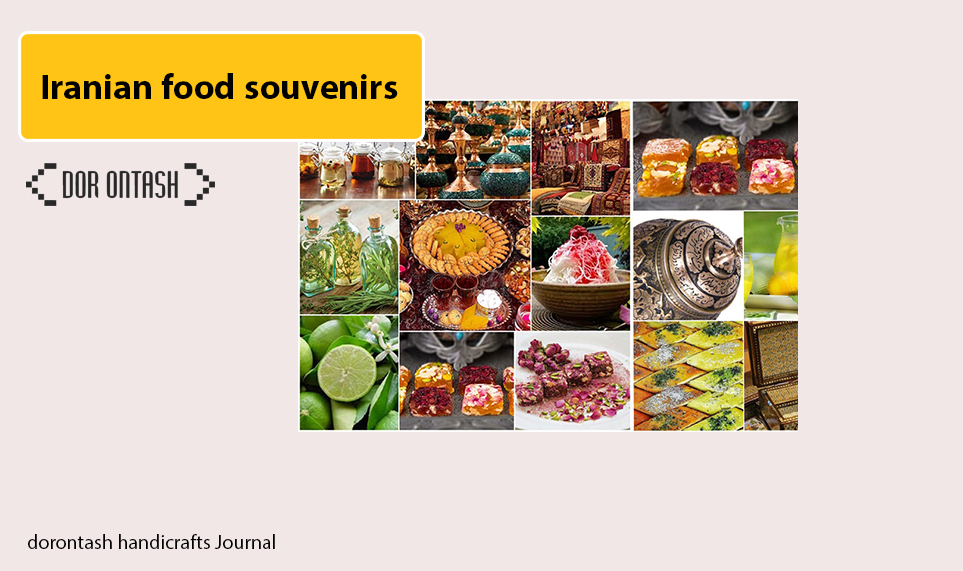Why visit the iran national jewelry treasury?
- It contains some of the best, most valuable and most beautiful jewels in Iran and the world.
- In this treasury, you can visit Darya Noor Diamond – the world’s largest pink diamond – Noor Al Ain Diamond, Kiani Taj, Naderi Takht, Tavus Takht, Jeweler’s Globe, Yellow, Black and Red Diamonds, the World’s Largest Lal and many other gems.
- By visiting this treasury, you can watch unique examples of jewelry, inlaid work and goldsmithing by artists from Iran and the world.
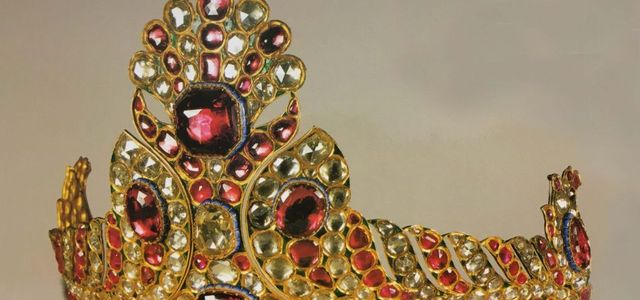
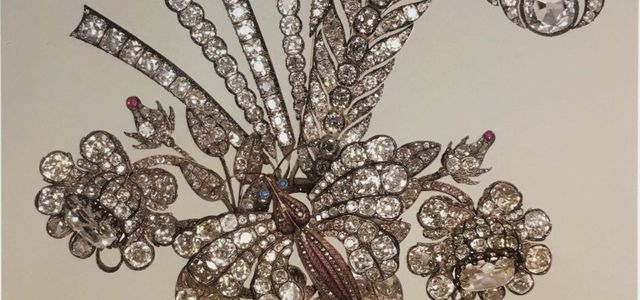
Getting to know the treasury of iran national jewelry
Today we are going to go to Ferdowsi Street in Tehran and visit one of the most unique buildings in the city. Where the building itself is not particularly attractive, but what is hidden inside makes it very special. The building of the Central Bank of Iran, which hosts the treasury of iran national jewelry and the hidden treasure of Iran’s earth. An incomparable treasure of very beautiful gold and jewels, which is considered one of the largest and most valuable collections of gold and jewels in the whole world. Jewels that have been gathered together over the centuries and made this unique and spectacular collection and drown you in the splendor of their beauty. These jewels are so valuable that they have been chosen as the basis of the national currency of Iran (1) and they are priceless. You read that right; They have no price because some of the gems kept in this collection are unique and unique in the world and no price has been set for them yet.
Now, join Carnival to introduce you to some of the best jewels of this collection and immerse yourself in watching their glory.
* Before starting our tour, we should consider that this place is not a museum, contrary to the name that has become famous among the people, but is a treasury of national jewels. Note that this place is different from all the museums you have seen so far and it is located in the basement of the central bank, in a large safe. Visiting the National Jewelry Treasury has strict rules that you must read the information and visiting rules section to learn about them. *
Footnote
1- Money in itself has no inherent value and is just a piece of paper. The value of money is created by standards such as gold, coins, precious metals, silver, currency, coin melting, inflation, economy, price increase, money supply, supply and demand, goods and services.


The treasures of the iran national jewelry treasury
National Jewelry Treasury has a unique and spectacular treasure of Iranian gold and jewelry. Without any additional explanation, we go to the best, most beautiful and most expensive treasures of this treasury.
The diamond of the sea of light
The most magnificent, beautiful and valuable gem of the treasury of national jewelry is the Diamond of the Sea of Light; The pink diamond, which is considered the largest pink diamond in the world and with a weight of 182 carats, is also considered one of the largest known diamonds in the world. Of course, it has been said that this diamond weighed more than this before cutting and has one of the rarest (pink is the rarest color among diamond colors) and the most exceptional colors among other diamonds in the world. A diamond with a legendary history that leaves every viewer in awe of its beauty.
Diamond decoration of the Sea of Light
Diamond of the Light Sea shined beautifully in one of the royal bracelets until the time of Naser al-Din Shah; But from this period onwards, when the use of the armband became obsolete, it became a charming helmet. A golden frame with designs of lions and suns and a crown studded with 457 small diamonds and four rubies have included this pink diamond. Darya Noor brilliant diamond is cut on both sides and all its surfaces are smooth and uniform; But on one side of it, the words “Sultan Sahibqran Fath Ali Shah Qajar 1244” can be seen. iran national jewelry
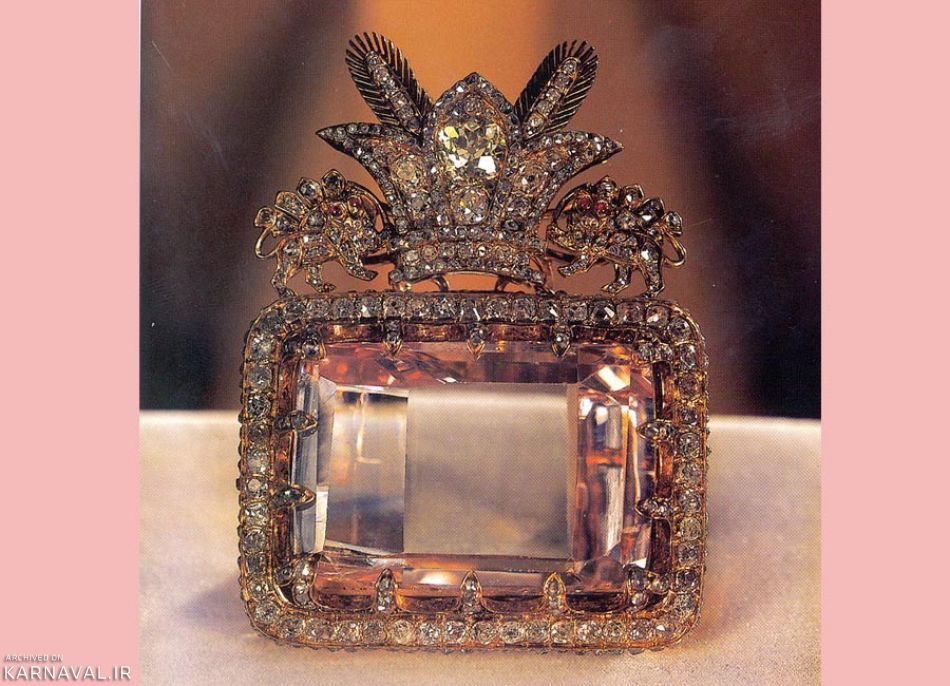
History of Darya Noor diamond
Traces of the Light Sea Diamond can be found in mythological and legendary stories. It has been said that this diamond shone on the hilt of the sword of Afrasiab, the king of Turani, and fell into his hand after the war of Rostam with the Turanis. But later, during the attack of Amir Timur, it was plundered and fell into the hands of Mohammad Shah of India.
Apart from these legends and stories, the first place in history to find information about the Sea of Light diamond is in Nader Shah Afshar’s war with India in 1793 AD (1172 AD). According to various narrations, it has been said that after the murder of Nader Shah, this diamond went to his grandson, and after that, Amir Alam Khan Khuzima was able to make it his own. Mohammad Hasan Khan Qajar, Lotf Ali Khan Zand and Agha Mohammad Khan Qajar were the next people who owned the Darya Noor diamond for a while. When this diamond reached the hands of Naser al-Din Shah, there was a special care for it, and he believed that this jewel was one of the crown jewels of Cyrus.
The Darya Noor Diamond was transferred to the Russian Embassy during the reign of Muhammad Ali Shah and when he was defeated by the constitutionalists. Fortunately, the constitutionalists were able to recover this jewel. Finally, the adventures of this magnificent diamond ended in the national treasury of Iran and from then on it was used as one of the foundations of the Iranian rial.
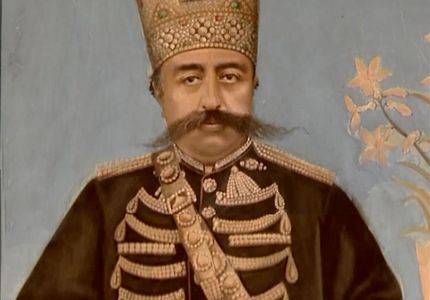


Jeweler’s sphere
Another valuable treasure of the iran national jewelry Museum is the jewelry globe that charms visitors at the end of the treasury hall. The big globe that is different from anything you have ever seen and the amount of gold and jewels used in it will make you stunned for a moment. This sphere was built in 1291 AH (1253 AD) by the order of Naseruddin Shah and with the efforts of a group of Iranian jewelers, and its construction was supervised by Ibrahim Meshii. Mr. Christian from Pawn Jewelry (1) which was available in the royal treasury, he used it and made the jeweled sphere with the help of his colleagues. In this globe, the seas are decorated with emeralds and the lands with rubies, and the countries of Iran, England, and Southeast Asia shine with white diamond gems, India with bright rubies, Central and South Africa with sapphires, among other places. Mount Damavand is marked with a large ruby, and a famous ruby named “Aurangzeb” is located in the current location of Tehran city.
Specifications of the jeweler’s sphere
This globe has a diameter of approximately 66 cm and is placed on a golden base decorated with jewels. The net weight of the gold used in it is 34 kg and the weight of its jewelry reaches 3656 grams. The total number of jewels installed on this sphere is 51366 pieces.
Footnote
1- A jewel that has not yet been used in making precious works.
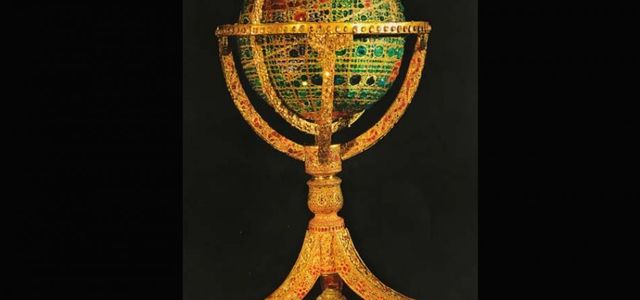
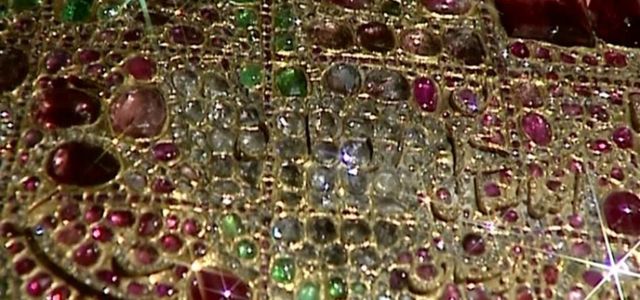
Taj Kiani
Another object that catches your eye while walking around the treasury hall is the magnificent Kiani crown. The crown that was made in 1212 A.H. (1177 AD) was built by order of Fath Ali Shah and was used by other Qajar kings as well. This crown was made for the first time after the collapse of the Sassanids, in the shape of the crowns of that period and decorated with diamonds, emeralds, rubies and pearls. Different fringes and congresses on the crown became its ornament and added to its beauty. If we do not consider the height of the crown, the height of the crown reaches 32 cm and its width reaches 19.5 cm. Since Reza Shah did not want to wear this crown, which was used by the Qajars, in the coronation ceremony, he ordered that the Kiani crown be transferred to the jewelry treasury forever. iran national jewelry
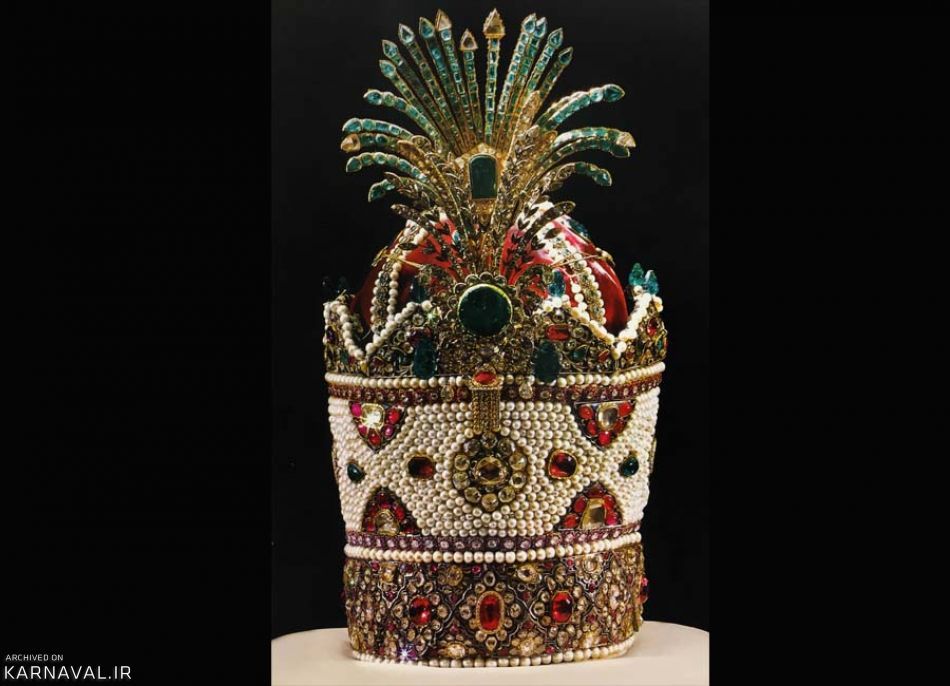
Taj Pahlavi
One of the most famous crowns in the national jewelry treasury is the Pahlavi crown, which was made by the order of Reza Shah and was placed on his and his son Mohammad Reza Shah’s crowning ceremony. A crown that was made in 1304 by a group of the most elite Iranian jewelers.
If you look carefully at the details of the Pahlavi crown, you will see a body made of gold and silver, decorated with brilliant diamonds, large emerald seeds, sapphires and pearls. The Taj hat is made of red velvet and a large emerald is visible on its dome. On the four sides of the crown, you can see step-by-step congresses in the style of the crown of the Sassanid kings, and under the front congress, there is a big yellow diamond, which has a sun shape with diamond rays around it.
The gems used in this crown include a total of 3,380 diamonds, 5 emeralds, 2 sapphires and 368 pearls. In general, the weight of the crown, including the velvet hat inside, reaches 444 shekels or two kilos and eighty grams.
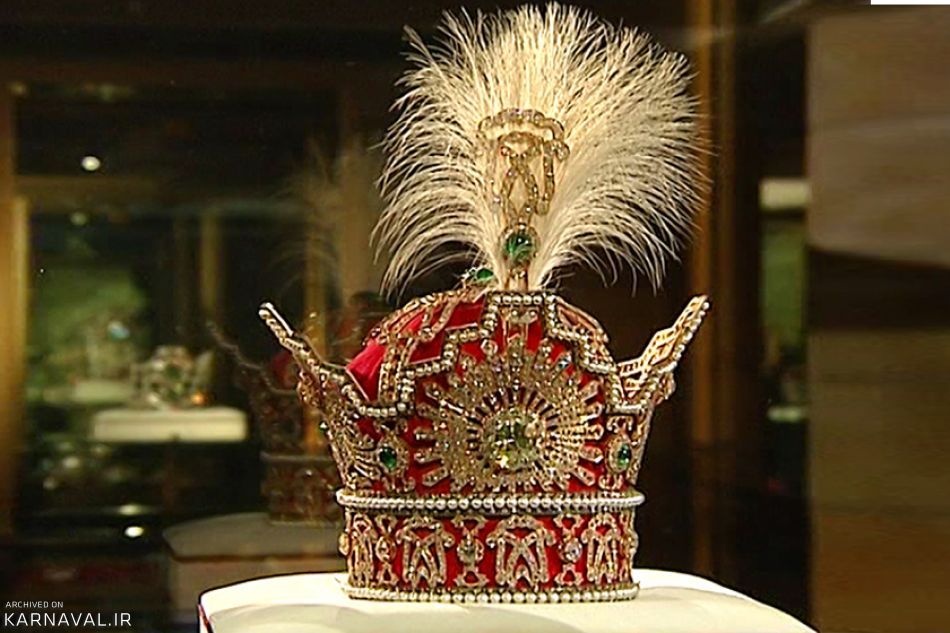
Nimtaj Noorul Ain
One of the most magnificent nimtajs in the treasury of the National Jewelry Treasury is Noorul Ain nimtaj, which was made for Farah Pahlavi, the third wife of Mohammad Reza Shah. This Nimtaj, which is the delicate and beautiful work of the famous New York jeweler, Harry Winston, was put on Farah Diba’s head in 1338 solar. A semi-crown with a rare pink diamond shining on top of it is said to be a part of the famous Darya Noor diamond. This tiara is placed on a platinum base and decorated with yellow, white and pink diamonds.
The interesting story about Nimtaj Noorul Ain goes back to 1344 and the time of the examination of national jewels by some Canadian scientists. In their research, they come across the writings of Tavernier – a famous French traveler and jeweler – who mentions a pink diamond weighing 242 carats in his book and mentions that he saw this diamond in the east in 1642 AD. In his description of this diamond, he mentions it by the name of Grand Table Diamante. These descriptions draw the attention of Canadian scientists to the Noor Sea and Noor Al Ain diamonds and investigate their characteristics. After their research, the scientists came to the conclusion that Darya Noor and Noor al-Ain diamonds were originally one piece of diamond, which was later divided into two pieces, and the larger piece was named Darya Noor and the smaller piece was called Noor Al Ain.
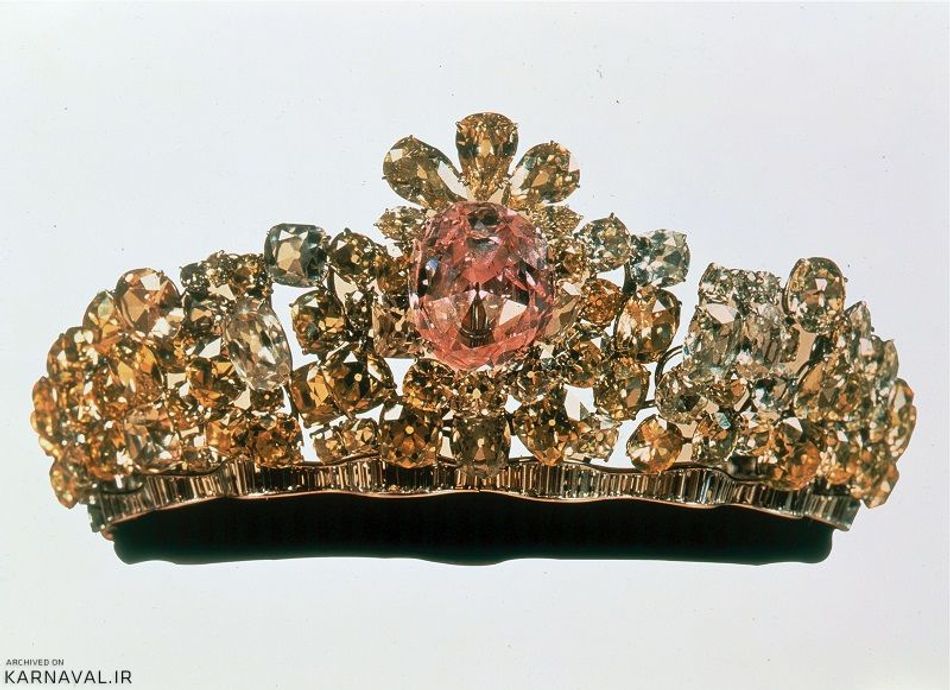
Jaqe Naderi | iran national jewelry
A rare necklace is considered one of the most famous jewels in Iran and was made in the 12th century. A work with a large and beautiful emerald in the middle, which is embraced by other diamonds and emeralds and created an exquisite and excellent jewel. The art of making jaqeh is not limited to using diamonds and emeralds to make it; To make his work of art even more magnificent, he has also used three emerald green emerald pendants under the collar. The upper part of the jacket is also divided into seven sections and on both sides of each section, two strands of leaves and a diamond flower can be seen. On the tips of the apartments, there are two very high Saeedi Amrudi emerald pendants, which show off the designer’s taste. On the top of the middle big emerald, there is a diamond crescent and on the bottom of it on both sides, there are shapes in the form of a cap, a drum, a cannon barrel and a bayonet. Darfash fabric is also decorated with three rows of rubies, diamonds and pale emeralds to bring the luxury of this jacket to the highest level.

A rare bed | iran national jewelry
During your tour in the hall of the jewelry vault, when you reach the end of the hall, the jeweler’s chair with special glitter will attract all your attention. This chair, called Takht Naderi, was made by order of Fath Ali Shah Qajar and with the efforts of Iranian jewelers and artisans. An inlaid and enameled bed with 22,000 pieces of precious stones and jewels decorated it in an original way, and since there is no bed like this in beauty and value, it is called Nader (meaning rare). It is said that Fath Ali Shah had ordered the construction of this bed while camping in Soltanieh Zanjan, and the makers made this chair in 9 separate pieces in order to be able to carry it more easily. Although this bed was only used during the king’s travels and the rest of the time it was next to the peacock bed in Salam Hall in Golestan Palace. It was nice. Of course, later during the Pahlavi era, the Naderi throne was moved from the Golestan Palace to the central bank’s royal jewelry treasury, and the last time this chair was used was during the coronation of Muhammad Reza Shah Pahlavi on November 4, 1346.
Features of a rare bed
The shape, composition and decorations of the Nadiri bed are more beautiful and impressive than the other famous bed of the Qajar period, namely the Peacock bed. The back which is sewn for this bed has a pattern of bergamot and big and small jewels that add to the beauty of the bed. Two twisted dragons or salamanders can be seen on the two sides of this back, whose heads are shaped like eagles or parrots, and they intend to show off the strength of the person sitting on it. The vertical wall of the first step of the bed is decorated with a prominent lion pattern and adds to the beauty and grandeur of the chair. Another decoration that will attract your attention in the interior is the pattern of two enameled parrots inside the slime mesh grilles.
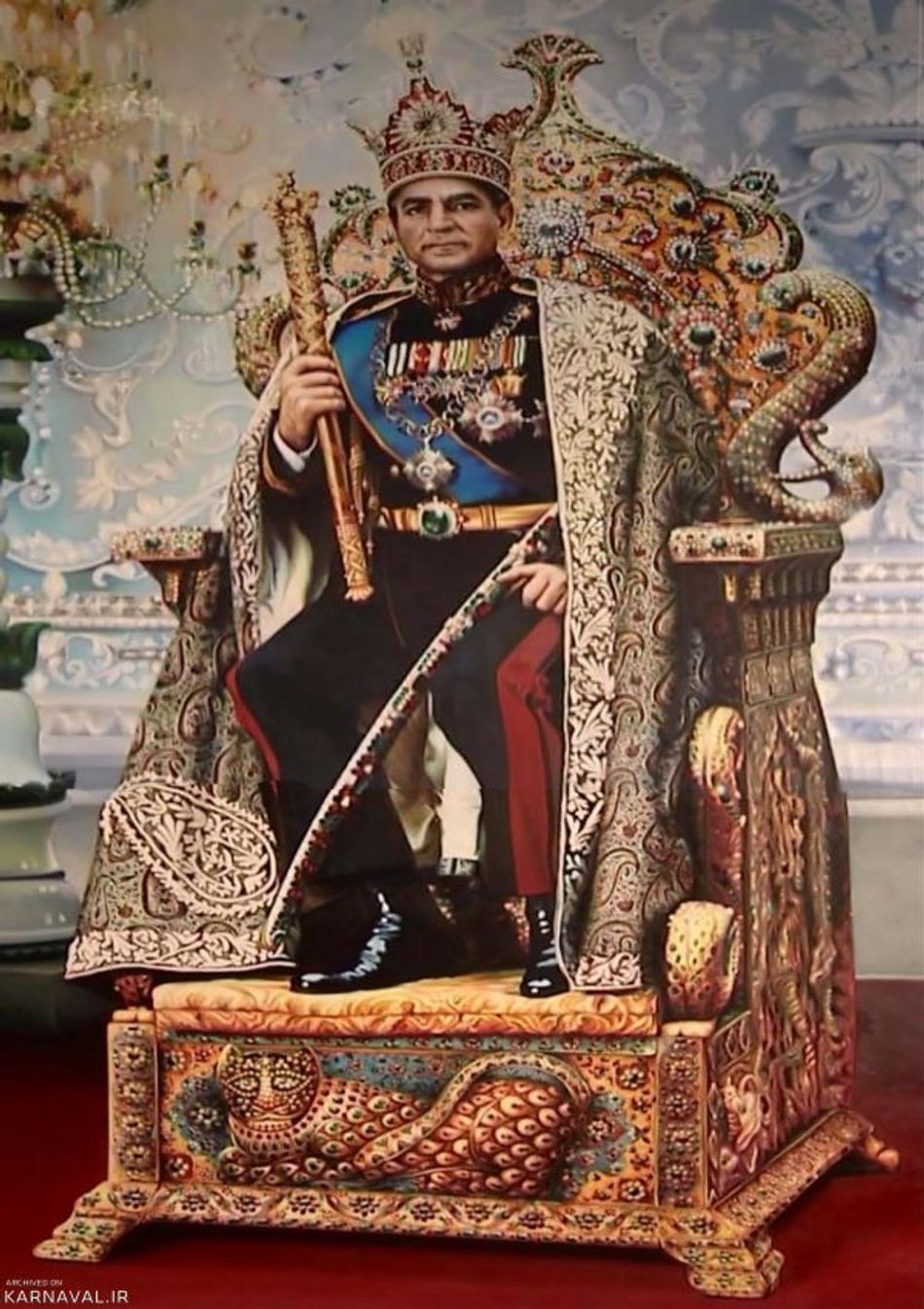

Peacock bed
Another luxurious treasure that can be found in the treasury of national jewelry is the huge and famous Takht Tavus or Takht Khursheed. This throne was built in 1216 AH (1180 AD) by order of Fath Ali Shah, and Nizam al-Dawlah Mohammad Hossein Khan Sadr Isfahani – the ruler of Isfahan – undertook the construction of it. Since the top of the throne has an inlaid solar motif, this throne was called the Sun Throne, but later on, on the occasion of the marriage of Fath Ali Shah with the peacock of Taj al-Dawlah, it became known as the Peacock Throne.
Of course, some Iranians thought that this bed was the same because the name of this bed is similar to the legendary Indian peacock bed (1) . But later research showed that this unique work was made by the order of Fath Ali Shah and has nothing to do with the rare peacock bed. Fath Ali Shah used this throne during public gatherings (the presence of people in front of the king) and meetings with foreign ministers, ambassadors, and officials, and he sat on top of it so that he could show off his imperial glory to them.
After the death of Fath Ali Shah, Naser al-Din Shah ordered repairs and changes to be made on the throne, and poems about how the throne was made were written on it. This bed was kept in the hall of Golestan Palace until 1360; But on the 17th of Shahrivar this year, it was transferred to Central Bank’s jewelry treasury so that the puzzle of royal jewels can be more complete in this treasury.
Footnote
1- Tavus Naderi throne was the name of the royal throne inscribed with the coat of arms that Nader Shah brought to Iran as booty after the war with India. It was known by this name because the design of two open peacocks was seen on the top of this bed. It is said that the diamond of Koh Noor was on top of this bed.
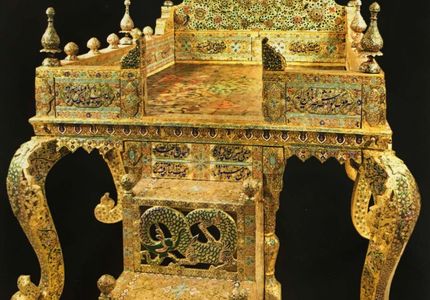

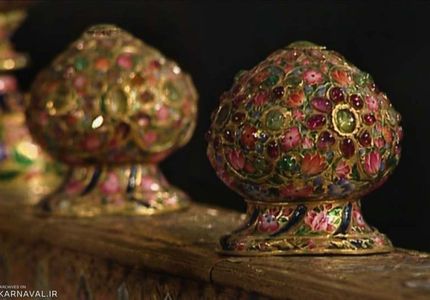
Queen’s crown and coronation necklace
Among other famous royal crowns of Iran’s National Jewels Treasury, there is a crown that was placed on Farah Pahlavi’s head during his coronation and was used only by him. The story of the construction of this crown is that after the protests of the 40s, Mohammad Reza Shah decided to implement reform programs in the form of the White Revolution. One of his actions in the form of this revolution was to grant freedom to Iranian women, and accordingly, in a symbolic move, he decided to organize a ceremony for the coronation of his wife, Farah Diba. This has never been done before and the wives of Iranian kings have never been crowned. This coronation needed a suitable crown and therefore the French jewelry company “Van Cleef & Arpels” was asked to do this work in a decent way. According to historical tradition, the stones and jewels in the royal treasury should be used to make the crown, and on the other hand, since it was not possible to take the royal jewels out of Iran, the French company had to come to Iran to make the crown. It took six months to make this crown and it became one of the most beautiful crowns in Iran.
Features of Taj Shahbanu
Farah Pahlavi’s crown has a white gold frame and is covered with a green velvet hat. It is decorated with 36 green emeralds, 105 pearls, 34 rubies, 2 spinels and 1469 diamond pieces, and a 92-carat green emerald in front of the crown gives it a special splendor. As Farah Diba has written in her memoirs, she describes this crown as very beautiful and at the same time very heavy, and considers its weight to be around two kilograms.
Farah Pahlavi’s coronation necklace
Among the other jewels used by Farah Pahlavi in her coronation ceremony was a beautiful emerald necklace, which later became known as the coronation necklace. Like Shah Bano’s crown, this necklace is made by skilled jewelers of the French company Van Cleef & Arpels and was used in her coronation ceremony.
Coronation necklace features
The material of the body of the necklace is made of gold and platinum, and in the middle of it, a large and cut emerald attracts attention. This large emerald is decorated with smaller emeralds and pearls of the same shape around it, and small white diamonds intersperse these emeralds. At the end, you can see the yellow diamonds that stand out right above the big emerald and have brought the glory of the necklace to its highest level.
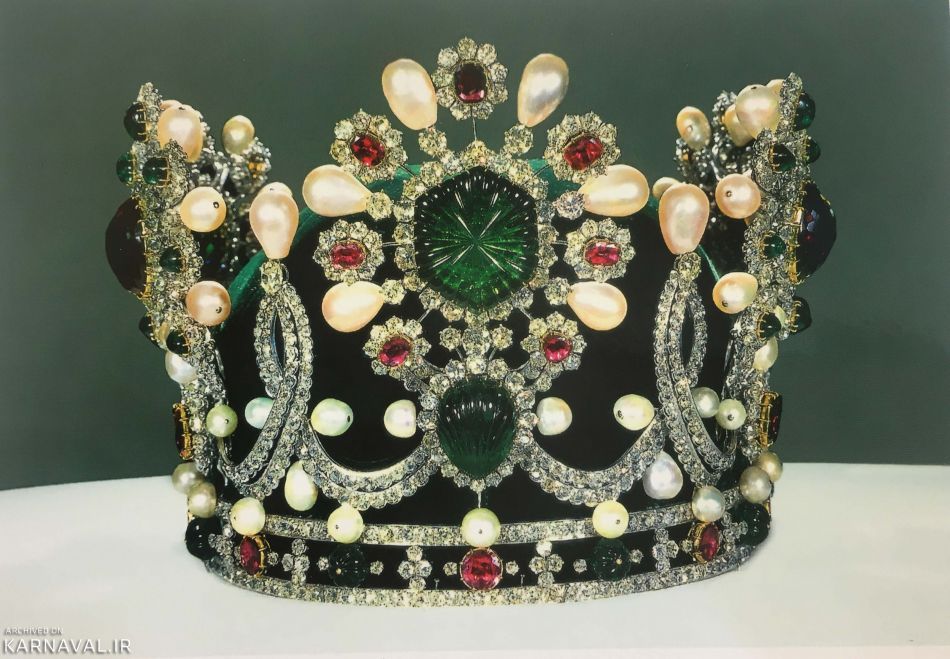
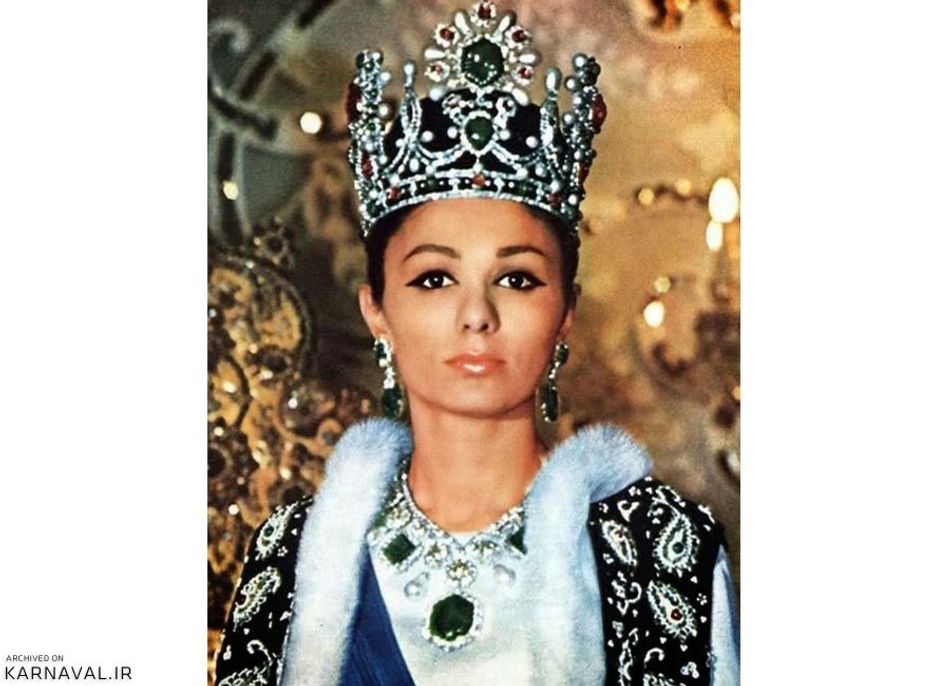
golden belt | iran national jewelry
The golden belt is another famous jewel of the National Jewelry Museum, which we visited during our visit. The belt, which consists of a 119 cm long woven cord, has a double shine with a unique oval-shaped emerald piece weighing 176 carats. This piece of emerald is decorated with 60 pieces of brilliant diamonds and 145 pieces of flamme diamonds, giving the belt a dazzling sparkle. This golden belt was ordered to be made by Naser al-Din Shah and was used by him in various gatherings.
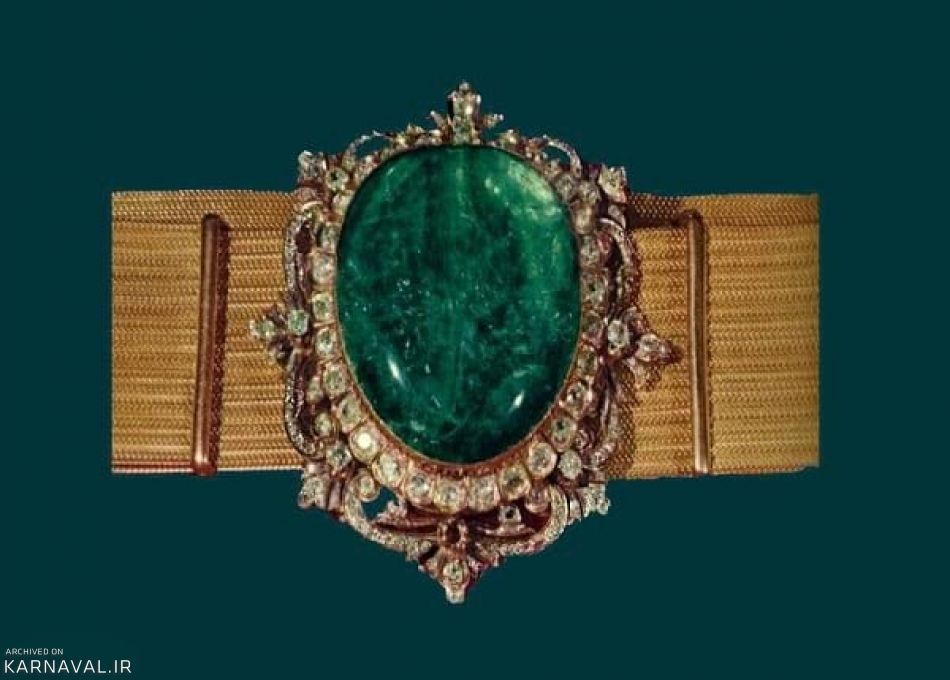
Diamond and emerald necklace
The diamond and emerald necklace is another beautiful piece of jewelry that has a silver base and precious stones such as emeralds and diamonds can be seen on it. The largest emerald used in the making of this necklace weighs 10 carats and seems to have belonged to Qamar al-Sultaneh, one of the Qajar princes and the daughter of Fath Ali Shah. Now, if we get a little more detailed in the details of this emerald and diamond necklace, around each emerald we see a frame of gold and then diamonds that surround them and make them more impressive.
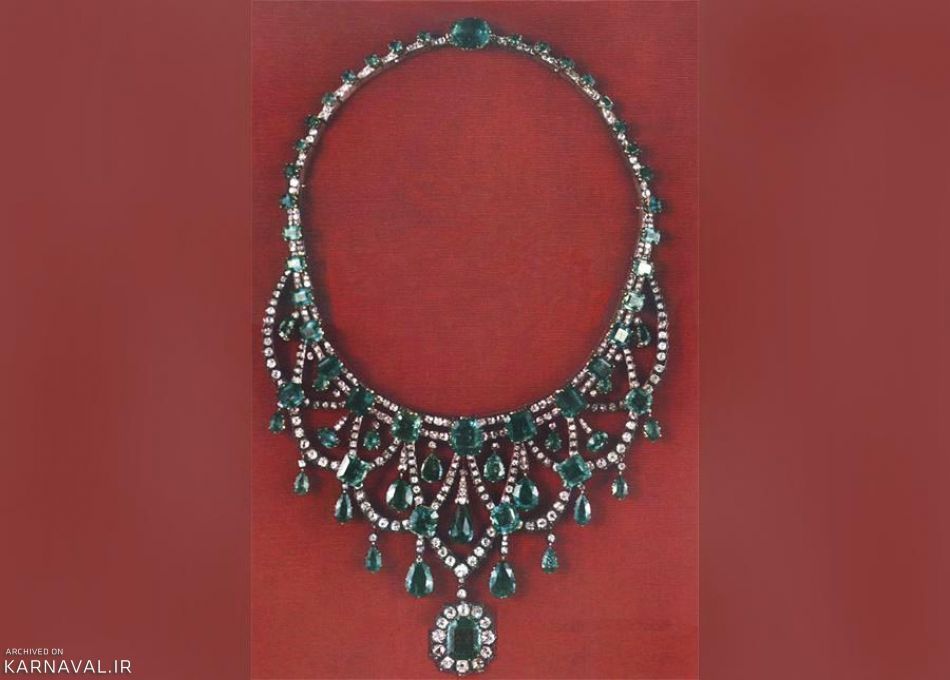
Royal hip sunbed
Maybe you will be surprised if you hear that hip bracelet is also part of the royal jewelry; But if you see this work closely, you will notice the decoration of the work and the jewels used in its construction and confirm why this work should be included in the treasury of royal jewels. Like many other jewels in the collection, this sunbed and royal basin dates back to the Qajar period and was used by the Qajar elders during lunch or dinner.
Features of the royal hip sunbed
Both the sunbed and the pelvis are made of pure gold and each is covered with stones such as enamel, emerald, ruby and spinel. If you pay attention to the details of the pelvis, you will see a large emerald that stands out in the middle. Two big stones are visible on the sunshade, one of them is a ruby weighing 22 carats and the other is an emerald weighing 30 carats.

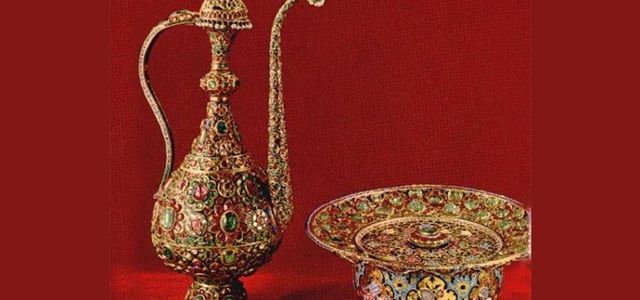
Swords, Daggers and Shields Collection of National Jewelry Treasury
Among the various objects and works of the national jewelry treasury, jeweled swords and shields have a special place and were used by kings, courtiers and princes in various ceremonies. In this section, we try to introduce some of the most important ones to you and get to know their features.
Sword of Fath Ali Shah Qajar
One of the most famous swords of the National Jewelry Treasury is the sword of Shah Qajar Fath Ali, which can be seen in many of his portraits. Fath Ali Shah was very fond of this sword and used it both in roles and in exercises. This caused many scratches on the handle of the sword. One of the unique features of this sword is its crescent-shaped blade, which dates back to ancient Iran. The steel used in making this sword is of high quality and there is an inscription with the name of Fath Ali Shah made of gold with the date of 1213 AH. The handle and scabbard of this royal sword are also decorated with emerald, ruby and diamond jewels and flower motifs.
Royal sword or royal sword
The royal or royal sword is another famous sword in the collection and belongs to Naser al-Din Shah. A sword that seems to have been given to him by the Grand Vizier of Naser al-Din Shah, Amin al-Sultan, and later became a part of the royal or luxurious dress for the coronation of the Qajar kings. The beauty, value and fame of this sword was so great that it was even used in the coronation ceremony of Mohammad Reza Shah Pahlavi. The unique feature that distinguishes this sword from others of its kind is its three curved bars, each of which has a snake pattern and ends in a diamond series. The royal sword is 1 meter long and has an inlaid handle and scabbard. The number of jewels used in this sword is 300, and the presence of two of the largest treasury emeralds, each weighing 110 carats, on this sword has increased its value a hundredfold.
Ivory hilt sword
This sword is also known as Yataqan in Persian and has a handle made of ivory and a straight blade 73 cm long (shorter than a normal sword). Its scabbard and handle are decorated with at least 10 large emeralds at regular intervals and floral motifs of jewels.
Nader Shah’s sword
One of the other exquisite swords that can be found in the treasury of national jewels is Nadershah Afshar’s sword. A 1-meter long sword that is said to have been carried by Nader Shah in his attack on India and won great victories with it. All kinds of gems such as emerald, diamond, lapis lazuli and ruby have decorated this piece of jewelry and given it royal glory. The number of diamonds used in this sword is 850, the weight of the largest of which reaches 20 carats. However, it has been said that Nader Shah himself used a simple sword and later this object was inlaid by order of Fath Ali Shah.
jeweled dagger
The jeweled dagger is a 40 cm long dagger that is larger than usual. The end of this dagger is slightly tilted and its handle and scabbard are decorated with red rubies, diamonds and emeralds. The largest ruby used to decorate this dagger is 60 carats and the inscription engraved on it dates it to the era of Fath Ali Shah.
A rare shield
One of the special objects of the jewelry treasury is Nader Shah Afshar’s shield, which he used in various wars. This shield is made of rhinoceros skin and has a diameter of 46 cm, and at first it had a simple cover; But later it was inlaid like a rare sword by the order of Fath Ali Shah Qajar. In the center of this shield, you can see one of the largest rubies in the world, weighing 225 carats, surrounded by a star of rows of diamonds, rubies and emeralds.
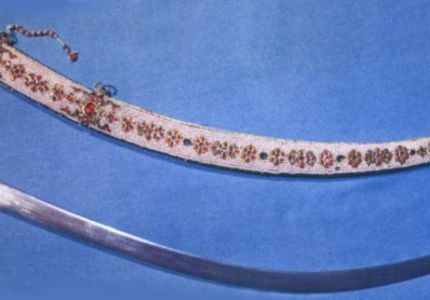
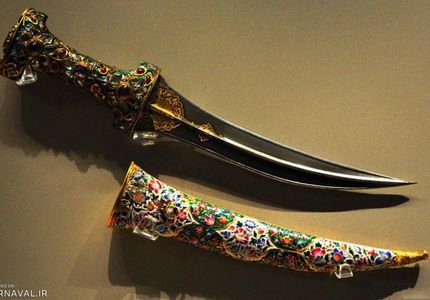
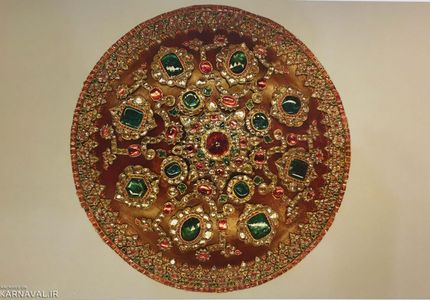
Abbas Mirza’s hat
Abbas Mirza’s hat (son of Fath Ali Shah and crown prince of Iran who failed to become king) is another work that you can enjoy watching the art used in its construction when you visit this collection. A hat made of satin fabric and red velvet, which is sewn with pearls and sequins, and a large emerald stands out on top of it.
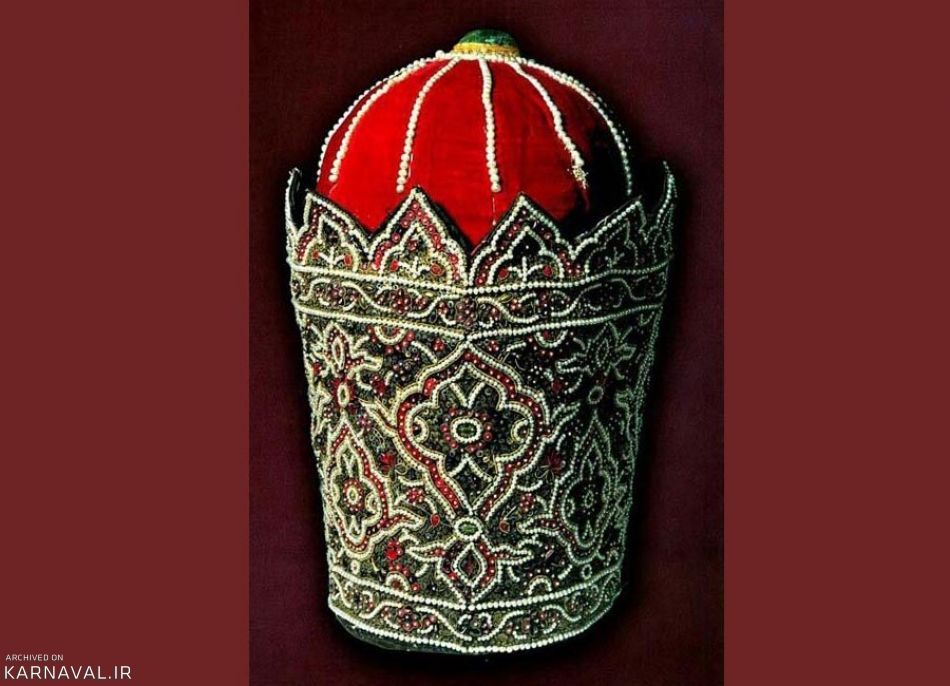
Kiani helmet
This particular jewel is the favorite decorative piece of Fath Ali Shah Qajar and is seen in most of the portraits of this king in front of his Kiani crown along with three black feathers. In the details of the front of the royal hat, if you pay attention, you will see precious stones such as diamonds, emeralds, lapis lazuli and red rubies, which stand out on a base of pure gold. Two big emeralds can be seen in the middle of this front hat, and its beauty is completed with two smaller emeralds.
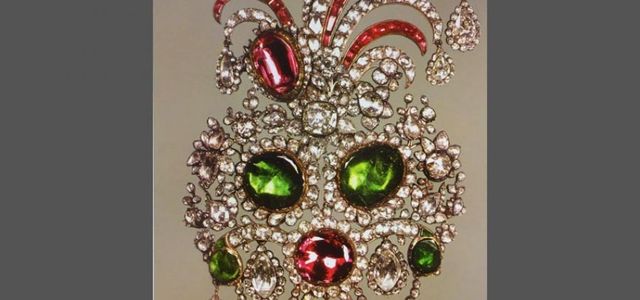

Collection of precious stones of the National Jewelry Treasury
All the jewels and works that we described to you are only a part of the charms and beauties of the treasury of national jewels. From each of the works that we have mentioned so far, there are many more examples, some of which are the works of Iranian artists and some of them are gifts from other countries and governments to the kings of Iran. But another interesting thing that attracts your attention when visiting the jewelry vault is the precious stones that cannot be seen anywhere else in the world. From the rows of tiny pearls that are made into long strings and used to decorate the curtains of palaces and houses, to the world’s largest red ruby (which is known as the Samaritan ruby according to an old legend), the world’s largest pink diamond and one of the world’s largest rubies. Another attractive collection that attracts attention among the jewelry here is the yellow African diamonds that Naseruddin Shah bought during his trip to Europe and some of them were used in making various jewelry. But the adventure in the stones of this collection does not end only with these yellow diamonds, there are red and black diamonds in the treasury of jewelry, which are very rare in the world and not everyone in the world gets to see them.


